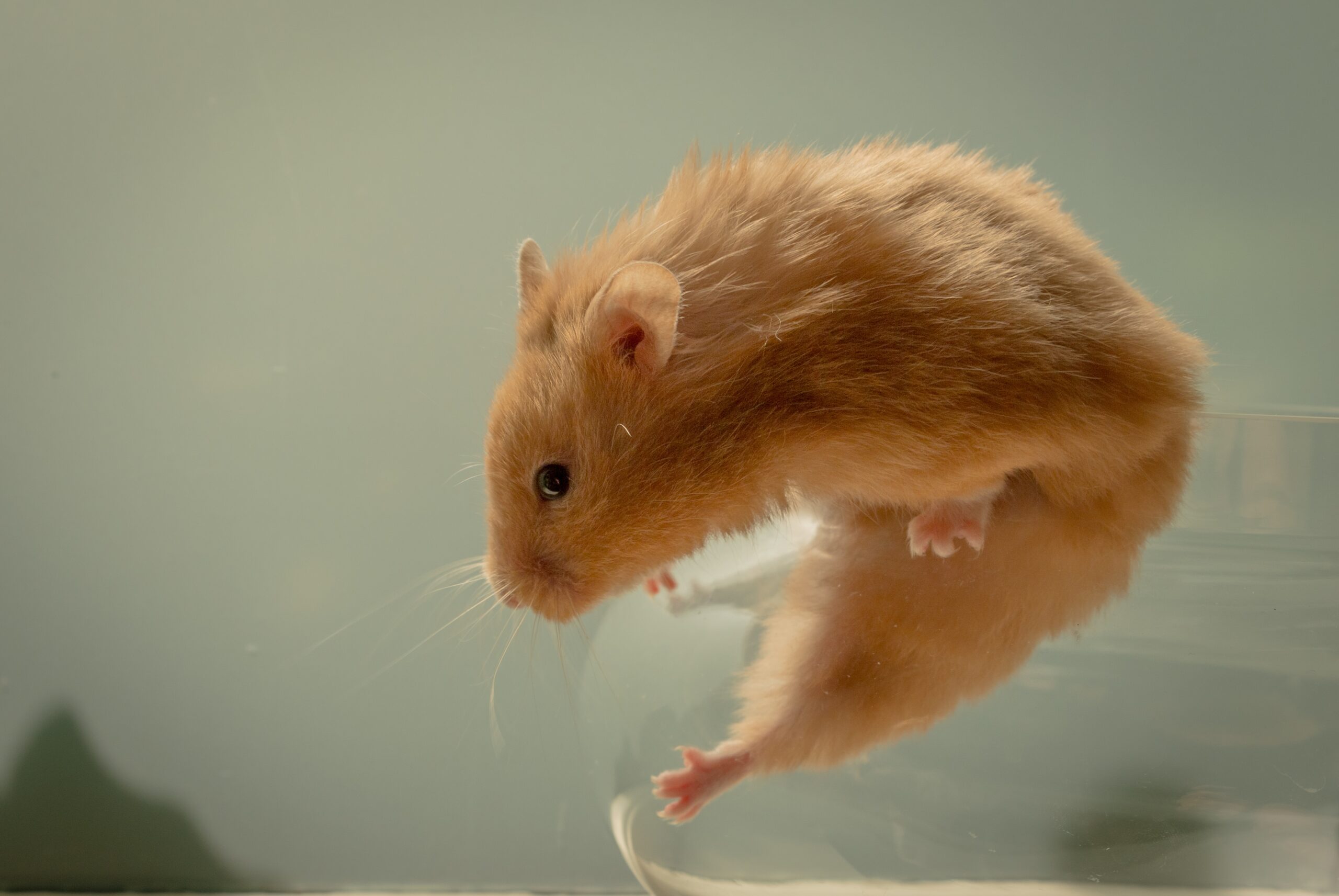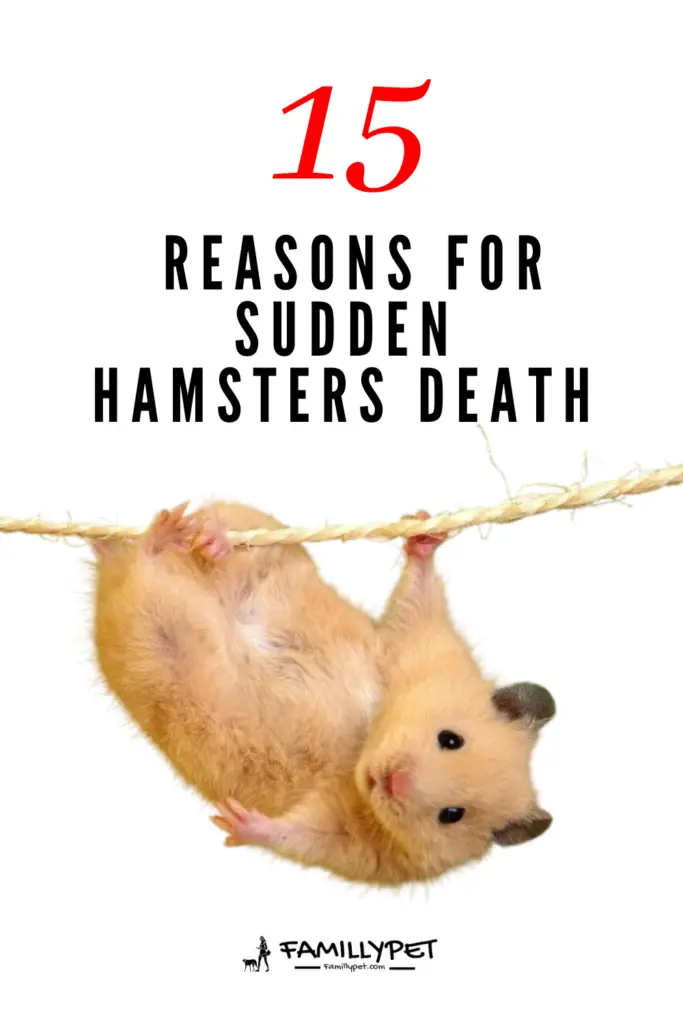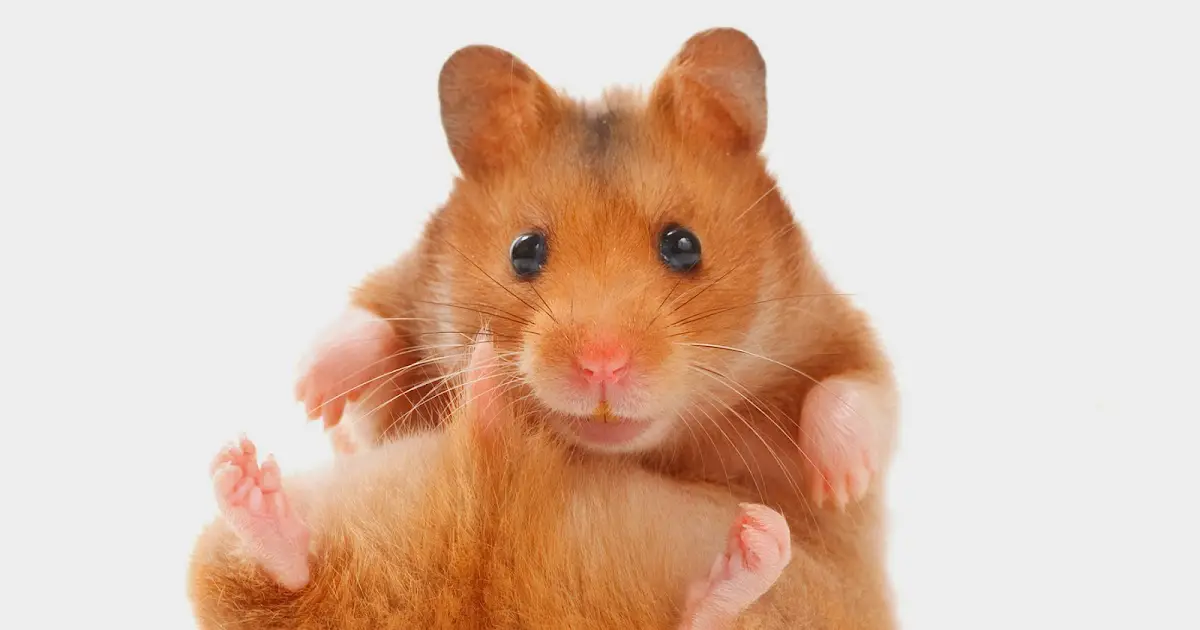- Why do hamsters die so easily?
- 1- Hamsters also die of old age
- 2- Hamsters can die because of bad genes
- 3- Hamsters may suddenly die from a fatal disease
- 4- Falling can be fatal for your hamster
- 5- Stress kills hamsters
- 6- A bad enclosure can cause your hamster’s death
- 7- Ignoring their diseases symptoms can cause your hamsters’ sudden death
- 8- Cage mates can fight and kill each other
- 9- Heat can also kill hamsters
- 10- Your other pets can kill a hamster
- 11- Boredom can indirectly kill a hamster
- 12- Bad diet will slowly kill your hamster
- 13- Contact with a sick animal could kill a hamster
- 14- Chewing on toxic things can cause your hamsters death
- 15- Hamsters may easily die from Dehydration
- Final thoughts:
- FAQ
Why do hamsters die so easily?
Hamster can suddenly die from direct causes such as old age, disease, a hidden injury, or a fall on its head, but also from indirect causes such as stress, malnutrition, lack of exercise, or poor hygiene in its enclosure.
Hamsters never die without a reason, it may appear like a really weird death but there is always a cause behind the sudden and unexpected death of a hamster.
The sudden death of a hamster is not always due to a severe illness, but hamsters can also die unexpectedly for a variety of other reasons, which I’ll also mention in this article.
I will answer this questions : how do hamsters die? and why do hamsters suddenly die? and help you to prevent the sudden death of your hamster, or at least to understand why hamsters sometimes die so easily believing that there was no reason or apparent diseases symptoms that would have alerted us long before this happened, and help you to prevent this sudden and unexpected death of a hamster.
Explaining the causes and signs of the impending death of the hamster in order to intervene in time and save it.
Now let’s move on to the reasons that can cause a hamster to a sudden and early death.
We will therefore see the multiple direct or indirect reasons why a hamster can suddenly succumb.

1- Hamsters also die of old age
The most common cause of a sudden hamster death is of course the natural cause, old age. Hamsters have a short life expectancy, even very short for some breeds, the hamster starts to get old just after 12 months and is considered an old hamster that will need special care, only after 18 months.
Hamsters die of old age sometimes just at the age of 24 to 30 months (2/2.5 years . 3.5 years for Syrian hamsters).
Amyloidosis is often the cause in this case, the internal organs of the hamster will cease to function well, and a severe weight loss will be the sign that precedes the sudden death of the hamster.
Keep reading to find out why do young hamster died suddenly?
2- Hamsters can die because of bad genes
Hybrid hamsters bred unethically are more prone to premature death due to their genetic disposition.
These hamsters, typically born in pet mills and often from parents with unknown health backgrounds, face higher risks of diseases and infections from the start. Their low birth immunity makes them vulnerable to fatal illnesses.
Conversely, hamsters obtained from dedicated breeders tend to live longer and often avoid visits to the vet altogether.
Bred from carefully selected and healthy parents, these hamsters lack hereditary diseases like Polymyopathy and Cardiomyopathy. They also exhibit robust resistance to stress, reducing the likelihood of stress-induced sudden death, particularly in cardiomyopathic hamsters.

3- Hamsters may suddenly die from a fatal disease
Hamsters can contract several diseases and infections, detected late or not treated in time, most of them can get worse and cause the death of a hamster.
There are some diseases that are more deadly than others, such as Wet Tail, it’s a spontaneous disease (proliferative ileitis) , a complete or partial obstruction of the ileum or Small bowel obstruction (this one kills 90% of hamsters in less than 48 hours).
Heart problems such as Congestive Heart Failure or Atrial thrombosis without forgetting the hepatic or biliary cysts that you, unfortunately, could not treat if they reach the liver of the hamster for example.
You should always be attentive and check your hamsters’ vital signs, I take this opportunity to tell you that small mammals pet insurance could always be useful, especially when the vet recommends internal surgery to save your hamster, so consider paying a few dollars per month ( usually less than $20 ) to be prepared for any sudden conditions or illnesses that may affect your hamsters.
The list of some common diseases that can kill a hamster:
According to the Royal Veterinary College and British Small Animal Veterinary Association , 7.33% of hamsters die of wait tail,5,88% from bite injuries, overgrown nail(s) 4.13%, overgrown front teeth (3.98%) and traumatic injury (3.80%).
| Diseases that Causes death in hamsters | All Hamsters (%) | Syrian Hamsters (%) |
| Unknown reason ! | 7.3 | 7.99 |
| Bite injuries from other hamsters | 5.88 | 3.01 |
| Overgrown nail(s) | 4.13 | 4.2 |
| Overgrown incisor(s) | 3.98 | 4.57 |
| Traumatic injury | 3.8 | 3.96 |
| Abdominal mass | 3.08 | 3.66 |
| Conjunctivitis | 3.05 | 3.12 |
| Ocular discharge | 2.83 | 3.32 |
| Diarrhoea | 2.8 | 3.22 |
| Wound | 2.75 | 2.24 |
| Mange | 2.65 | 2.78 |
| Abscess | 2.45 | 2.4 |
| Alopecia | 2.13 | 2.34 |
| Skin lesions | 1.98 | 1.86 |
| Upper respiratory tract infection | 1.95 | 2.24 |
| Anorexia | 1.85 | 2.2 |
| Neoplasia | 1.85 | 2.2 |
| Bite injury (self inflicted) | 1.75 | 0.68 |
| Dyspnoea | 1.63 | 1,66 |
Let’s see some of these fatal hamsters diseases :
A- Cold can also cause a hamster’s death
You can transmit the flu to your hamster and it can quickly become fatal if not treated in time, it can quickly become a serious lung infection, its symptoms in hamsters can be a wet nose, runny eyes, coughing, sneezing, and difficulty breathing.
If the flu virus is not treated, the hamster can have a respiratory problem and die if nothing is done to treat it
Do not ignore the flu when it is detected in your hamster, getting a cold can quickly become fatal, avoid frequent changes in ambient temperature and never leave your hamster’s enclosure exposed to drafts.
Cold weather can also shorten your furry friend’s life, it may get in torpor and never wakes up, this happens when hamsters get dehydrated while in that pre-hibernation state. This is why you absolutely have to always make some changes in your hamster’s enclosure and diet when winter is coming.
B- Heart diseases are often fatal in hamsters
Some hamsters are born with genetic heart diseases such as Polymyopathy and Cardiomyopathy, and the hamster’s heart becomes fragile. A hamster that suffers from chronic stress may suddenly die from heart failure if it has this disease.
Congestive cardiomyopathy, an inherited heart disease, often causes sudden death by heart failure in hamsters older than one year.
Older hamsters can also suddenly die of Atrial thrombosis, the heart becomes weak in this case and you notice that your hamster has quick breathing, swelling in the abdomen and blood does not reach the extremities of the body of your hamster (bluish color to the feet and the skin) and death will usually occur within a few days after the appearance of these symptoms.
Cardiomyopathic Hamsters (CM hamsters) often have a short life expectancy, about a year, so it is often advisable to buy your hamster from a passionate breeder to avoid these hereditary diseases, common in hamsters sold in malls and pet stores.
C- Cancer is often a fatal disease in hamsters
Hamsters can suddenly become anorexic and mysteriously die of spontaneous malignancy, including skin cancer (melanoma), gastrointestinal tract cancer or the hematopoietic system (Lymphoma).
Cancer which affects more winter white dwarf hamsters (of the digestive system or of the skin) and pneumonia or pulmonary infections come in second place of the deadly diseases of hamsters.
Other infections can also kill a hamster, the ones that make the most victims are LMCV and HaPV.
Finally, we find diabetes which affects and may kill more dwarf hamsters, you may notice increased thirst and more peeing ( strong-smelling pee ).
kidney failure which is also fatal if not detected and treated in time. Degenerative renal diseases usually affect and kill older hamsters, especially female hamsters, but also hamsters that receive an excess of fatty treats.
Other hamster diseases such as flu, skin or eye infections, or simple diarrhea can be easily treated and are very rarely fatal.
Hamsters older than one year can also become victims of Polycystic disease, this fatal disease affects mostly some internal organs like the liver, esophagus or Pancreas of the hamster.
In this case, the hamster will usually die without any external signs or symptoms.

D- Pneumonia is a lethal disease in hamsters
Pneumonia (inflammation of the lungs) is often caused by bacteria, it is also very contagious and can quickly become deadly when the hamster is subject to stress such as sudden temperature change…etc
You will recognize it if your hamster shows symptoms such as Mucus discharge, difficulty breathing, Constant sneezing and depression.
4- Falling can be fatal for your hamster
Hamsters also die after some falls, most of them are without consequences, but some falls can kill a hamster on the spot.
A hamster that falls from a great height and has nothing underneath to break its fall will probably die of internal bleeding.
The same for a hamster that falls on its head, it may break its neck and join hamster heaven, and the same for a hamster that falls on a hard object.
5- Stress kills hamsters
The indirect cause that kills hamsters the most is stress. Stress does not directly kill the hamster, but it weakens its immune system and makes it more prone to contracting deadly diseases like wet tail (A hamster that has a wet tail may still die after 48 hours in spite of care, and this is due to obstruction of the ileum, so watch your hamster) and heart problems. Stress may also exacerbate preexisting conditions, especially heart ones!
Stress can actually kill your hamster in less than a week, excessive salivation, hyperactivity, constipation, and refusal to feed are the most common symptoms of stress.
6- A bad enclosure can cause your hamster’s death
The hamster enclosure should have at least 1000 square inches of continuous floor space. Hamsters are very active animals at night and need to have space to exercise and plenty of elements and enrichments to help them do so.
A small cage and lack of enrichment can cause your hamster stress, obesity, and other heart diseases that can easily kill your hamster.
The wrong choice of bedding or delay in changing it and the sand that you put in the sandbath can also cause lung infections in your hamster and cause death.
Finally, Neglect and the bad hygiene of the enclosure and its elements, sound pollution (noise) and olfactory (smells and perfumes ..etc), and continuous exposure to artificial light can also be indirect causes that will quickly trigger incurable and fatal hamster diseases.
7- Ignoring their diseases symptoms can cause your hamsters’ sudden death
Hamsters hide their illnesses very well, this is normal because they are prey and if you do not learn to detect the symptoms of these diseases and the changes in your hamster’s behavior when it is sick, know that you have facilitated its death if it occurs.
So always pay attention to your hamster’s behavior and learn how to detect hamster illnesses so you can treat them before they get worse and become deadly and incurable.
You should also get a first aid kit, which will contain everything you need, not only to treat your hamster’s small wounds and rehydrate him…, but especially to give him first aid and save his life in case of serious diseases while waiting to take him to the vet.
Keeping your hamster’s temperature stable on the way to the vet or giving him a few drops of water with a syringe could save his life for example.

8- Cage mates can fight and kill each other
Hamsters are solitary animals and should be put in separate cages at the latest at the age of 6 weeks, otherwise, the turf war will start, and the weaker hamster will sooner or later succumb to its injuries caused by its stronger cage mates.
When you put two adult hamsters together, be aware that one of them, the weaker or dominated one, will suffer from poor nutrition and chronic stress and will probably not survive this situation for long and will die very quickly either from injuries, food insufficiency, anorexia or wet tail due to the stress caused by the bad treatment it will receive from its cage mate.
Female hamsters can also kill the male after mating, she will try to chase him out of the cage and if you leave him in, she will surely kill him.
9- Heat can also kill hamsters
You have probably heard of heat stroke, yes, the ideal temperature for a hamster is between 75°F and 80°F (24°-27°C), and when it is too hot in your hamster’s enclosure, its blood will thicken and its internal organs will not be irrigated normally anymore which will quickly cause a failure of the hamster’s internal organs and death if you don’t intervene in time. That’s why you need to learn how to care for your hamster when the weather gets too hot to avoid this.
The cold does not usually kill hamsters but it will push them into hibernation and you can kill your hamster if you don’t know how to get it out of this state of torpor by gradually warming it up and giving it something caloric to eat or drink.
10- Your other pets can kill a hamster
The cat will not miss a hamster, it may not eat it, but it will play with it like a ball, and even if your hamster will not be killed on the spot, it will surely not survive the stress that this encounter with your cat or dog will cause.
So secure your hamster’s cage so that your cat can’t get in or even get close to it, and especially so that your hamster can’t escape during the night and have bad encounters or fatal falls.
Also, a hamster that escapes from its cage and finds a way out of your house is in serious danger if you don’t find it very soon. It will surely fall victim to hunger, cold, stray cats and dogs, vehicles, and natural predators.
11- Boredom can indirectly kill a hamster
A hamster is meant to roam in the wild, not to be confined in an enclosure. Hamsters travel an average of 5.5 miles each night in their natural habitat.
Your hamster will get bored, stressed, and stop feeding if you don’t get him some enrichment and give him something to do at night, a wheel adapted to his size, toys to chew on, puzzles, things to climb on, a good thickness of bedding to dig in, tunnels, hideouts, seeds hidden in the enclosure, a sandbox large enough for sand bathing…etc
Never let your hamster get bored if you don’t want to shorten his life, lack of space coupled with boredom leads to chronical stress and kills hamsters
Playpens and outings outside the cage are also a necessity, so tame your hamster and schedule at least 15 to 30 minutes of play and interaction with him every day, preferably at night. Install a playpen or just a room where your cat should not have access and play and share time with your hamster.
12- Bad diet will slowly kill your hamster
As I said before, stress and poor diet are the two factors that usually determine how long your hamster will live.
As far as diet is concerned; the hamster will not be able to live long on pellets alone!
This is really absurd because the hamster needs essentially seeds, dry and fresh vegetables, herbs and flowers, and protein foods like mealworms, and crickets …
A poorly fed hamster will either suffer from malnutrition followed by anorexia or digestive problems that will quickly become fatal, or it will quickly become obese and will quickly become a victim of heart disease or diabetes that will surely end up killing it.
So make sure you feed your hamster well if you want it to live long and in excellent health.
Also avoid poisoning your hamster by feeding it dangerous foods such as chocolate, milk, peanut butter, honey, garlic, and onion, citrus fruits such as lemon, parsley, celery, onion, and basil, curly lettuce, and beans, and all frozen vegetables.
Also avoid fruits that are too sweet and especially in excess, no more than a piece the size of your pinky nail and only two to three times a week.
Do not poison your hamster with fat and raw meat, it will surely not eat them on the spot and will take them to its nest, the purification will do the rest and contaminate all its food and can even make it sick and poison it.
13- Contact with a sick animal could kill a hamster
It is rare that hamsters die just after contact with another sick pet or animal. I have often heard of hamsters being visited by a rat or even a wild mouse at night, attracted by the smell of food emanating from the hamster cage.
Don’t be surprised, but the food stored by the hamster may attract visitors you don’t even know are in your home.
A cockroach, for example, can carry bacteria or pathogens and microbes that will easily cause your hamster’s death.
So make sure you isolate your hamster from other small animals, insects, ticks and bugs.

14- Chewing on toxic things can cause your hamsters death
Hamsters have to constantly wear out their incisors and if there are toxic elements in their enclosure, like mazes built with plastic-based and toxic hot glue (not child-safe), some inappropriate toys, Popsicle sticks, painted objects (with acrylic paint)… etc, your hamster can chew them and die of intoxication or even just of blockage.
When you have a repair to do in your hamster’s enclosure or you just want to build some new mazes, do not use glue or ordinary adhesives; use natural materials but especially white glue and products recognized as “child-safe”.)
15- Hamsters may easily die from Dehydration
During the hot season, hamsters need constant access to cool water to regulate their temperature and if your hamster has diarrhea or difficulty drinking, it can quickly become dehydrated and die if you do not intervene.
If your hamster has sunken eyes, difficulty breathing, dry mucous membranes, and becomes weak and lethargic, you must quickly help him to rehydrate by giving him fruits or vegetables rich in water, and electrolyte water with a syringe.
Hamsters can only go for 3 days without water also note that hamsters can die from anorexia and starvation, so don’t leave your hamster without food or water, and make sure its water bottle/bowl is always fresh and clean.
Final thoughts:
Most hamsters live their whole lives without seeing a vet, especially if you take good care of them.
It’s good to want to ensure your hamster lives a long life without too many trips to the vet, but you should know that death is a part of life.
You should be prepared to say goodbye to your hamster at any time because you never know when it will leave you.
It’s not just old hamsters that die, young ones can also have internal diseases that you or a veterinarian would never guess.
You should let your hamster go in peace to the hamster’s heaven and even make the trip easier with euthanasia if the vet confirms that there is nothing more to do to save him and he is suffering.
FAQ
How long do hamsters live?
Studies show that The average lifespan of pet hamsters is 1.75 years (21 months).
Syrian hamsters can live just over 3 years while Chinese and dwarf hamsters can reach 2.5 years. hamsters are quite weak but this is not a reason for them to die so randomly, so let’s see the main reasons that can cause the early death of a hamster and how to avoid them.
So, let’s see why hamsters die without warning and how to make them live longer.
How do hamsters die ?
Since hamsters are so fragile, If you don’t learn to detect their diseases before they become serious they can easily die if you don’t take good care of them. Even though many things can cause a hamster to die unexpectedly, it’s still quite easy to take care of your hamster and help him live a long and healthy life.
You’ll get 18 tips on how to help your hamster live a long and healthy life by the end of this article.
Signs a hamster is ill and dying
If you are worried about your hamster’s health, here are the signs and symptoms that it is ” seriously ” ill and that you should take it to the vet:
- If your hamster is not as active as usual, is it lethargic?
- If your hamster refuses to eat ( you notice weight loss ) or drink ( dehydrated hamster or excessive water consumption)
- If your hamster seems dirty (neglected or messy coat) or on the contrary, if it does not stop licking its hair! ( unusual excessive grooming)
- Loose stools or wetness around the genital region (severe diarrhea or constipation or no stool in the cage)
- If your hamster huddles in the corner of his cage (hunched posture) and you notice quick breathing)
- If your hamster spends much more time than usual sleeping (young hamsters are very active).
- If you notice a swelling in your hamster’s abdomen, the color of its skin and its feet becomes a little bluish (heart problem)
- strong-smelling urine (a sign of diabetes ).
Why is My Hamster Trying to Kill Itself?
Hamsters do not commit suicide as many people think!
They just sometimes do silly things that may cause their unexpected death like jumping off your hands while you are standing or using their wheel for hours on end even when it’s hot and without taking a break to hydrate themselves or getting stuck in the bars of their cage…etc
Unfortunately, this kind of behavior can quickly become dangerous and cause the sudden death of the hamster, but we can not say that the hamster committed suicide, he just did something stupid that caused his early death!
So you should always keep an eye on your hamster and intervene if you see that it is putting its life in danger.
Some Useful Sources
1. PubMed – Characterization of stress-induced sudden death in hamsters https://pubmed.ncbi.nlm.nih.gov/9435170/
2. Yahoo News – Revealed: Why hamsters die https://news.yahoo.com/revealed-why-hamsters-die-235036418.html
3. Wiley Online Library – Demography, disorders and mortality of pet hamsters https://onlinelibrary.wiley.com/doi/full/10.1111/jsap.13527
4. Merck Veterinary Manual – Disorders and Diseases of Hamsters
https://www.msdvetmanual.com/all-other-pets/hamsters/disorders-and-diseases-of-hamsters
5. Axolotls, Mexican Salamanders as Pets


